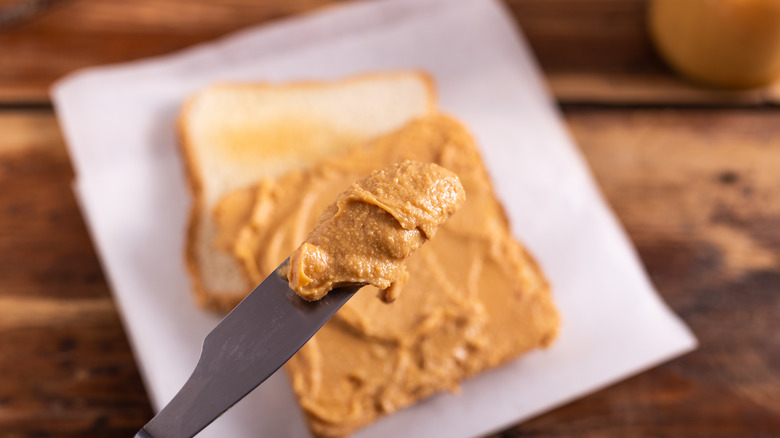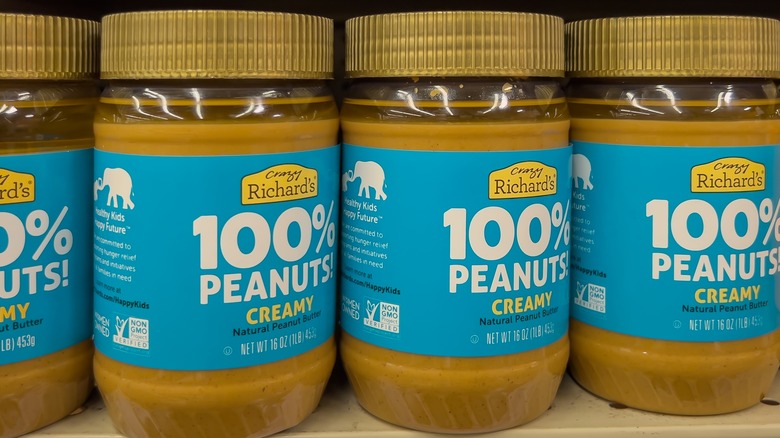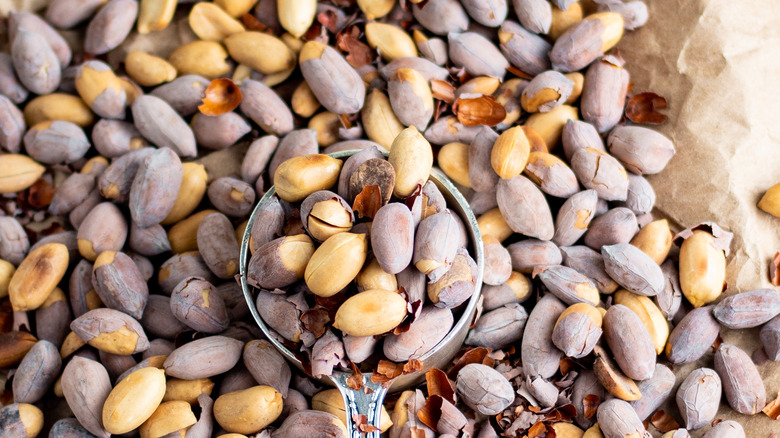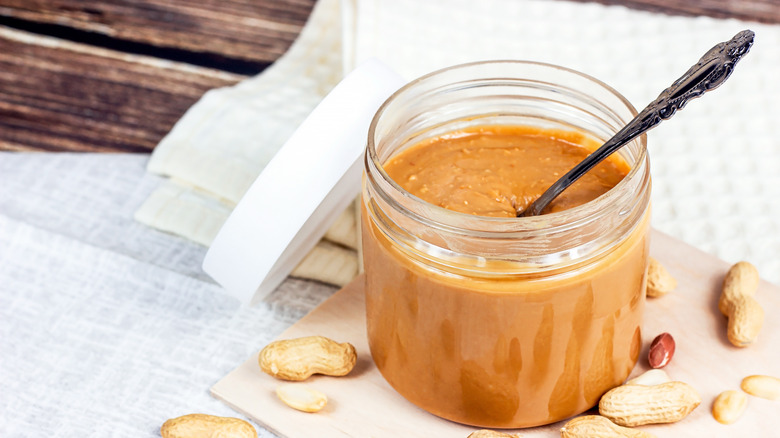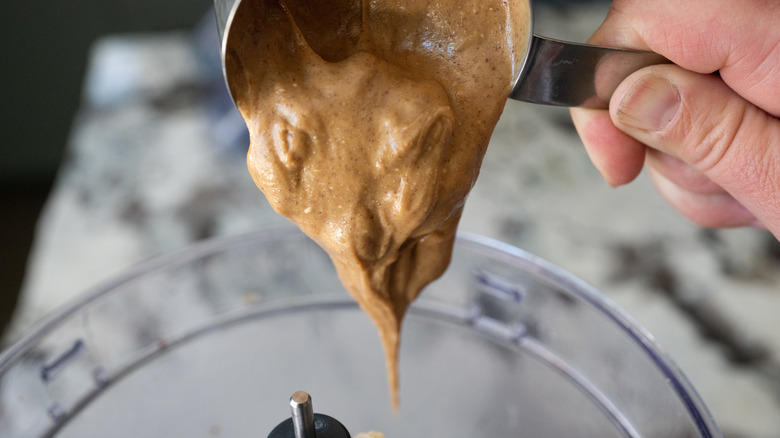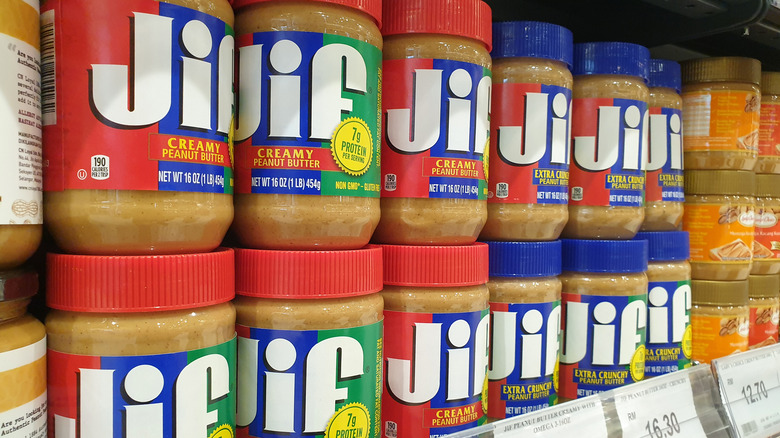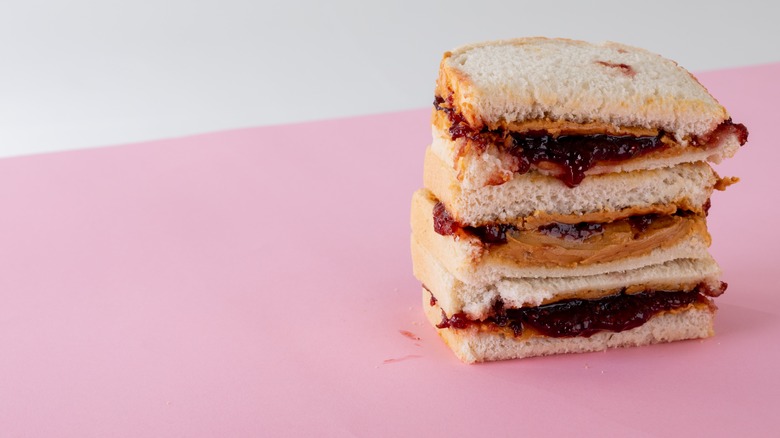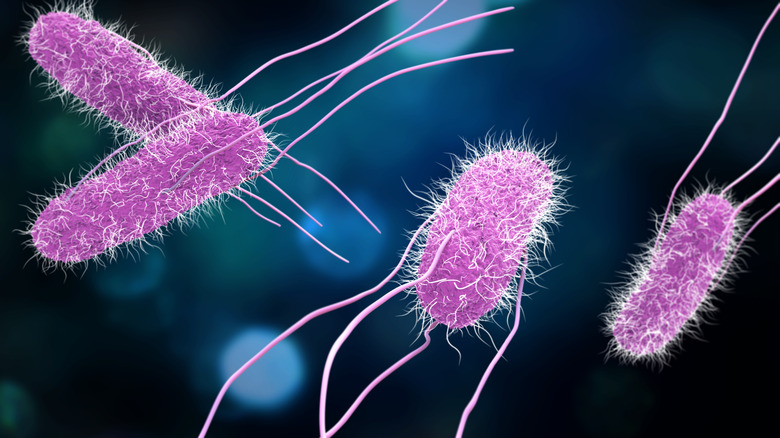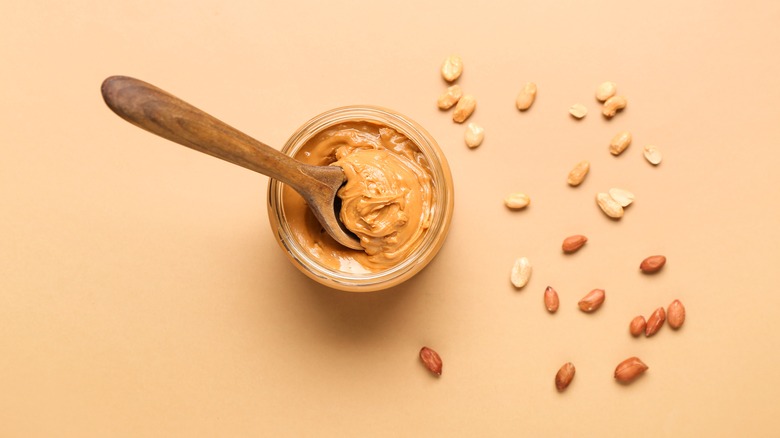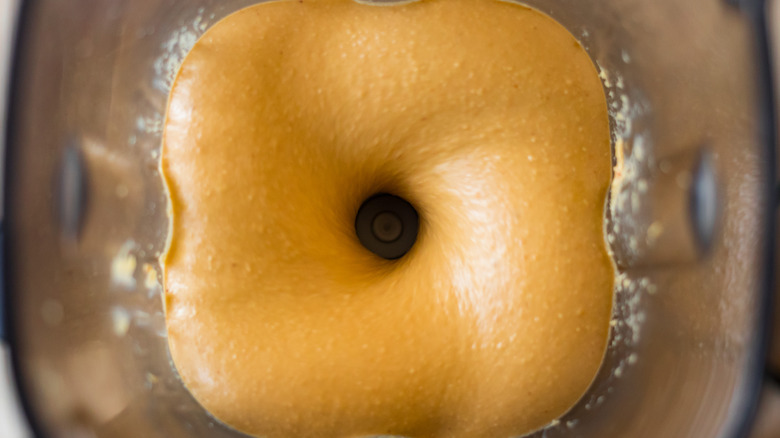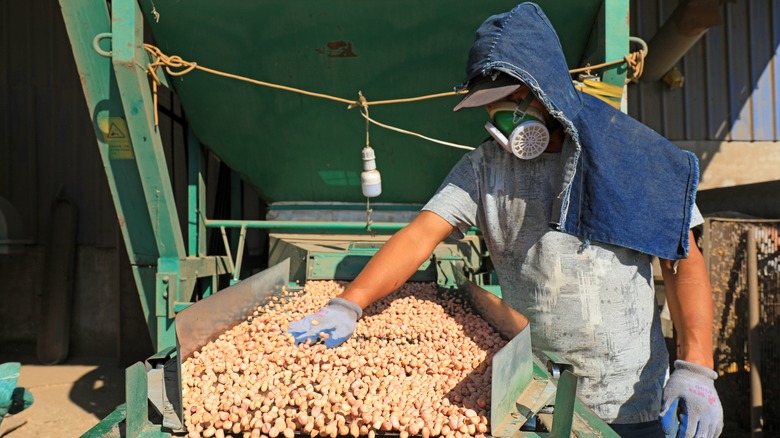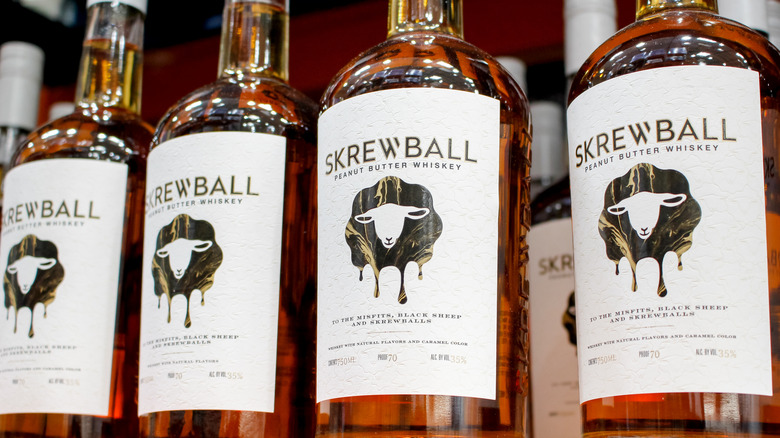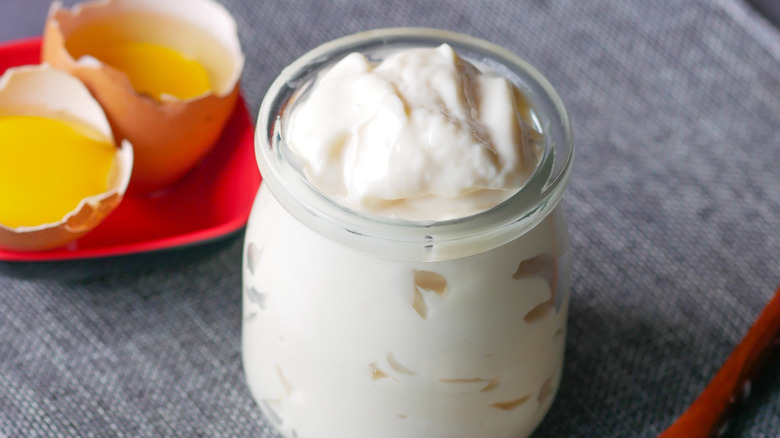15 Facts About Peanut Butter You Should Know
No American lunchbox would be complete without a peanut butter and jelly sandwich. The peanut butter component in this sandwich has a very long and somewhat confusing history. However, it has reigned supreme as one of our favorite baking ingredients, breakfast spreads, and snacking staples. The average American will eat 3 pounds of peanut butter each year, which brings the national total close to 700 million pounds annually. In addition, the average American child will eat more than 1,500 peanut butter sandwiches by the time they graduate high school. That's a whole lot of peanut butter!
The popularity of peanut butter has also sparked debates in households nationwide. A survey compiled by Jif polled 2,000 Americans and found that for half of the respondents, "it would be a deal-breaker to find out their date is on the opposite side of the creamy versus crunchy debate." Although we can't tell you which type of peanut butter we prefer more, we can tell you some fun facts about America's favorite nutty spread.
Peanut butter is a nutrient-dense food
One of the reasons why peanut butter is such a popular food is because it's full of nutrients, healthy fats, and protein. Two tablespoons of peanut butter can contain 7 grams of protein and several grams of fiber, along with a decent amount of added sugar, if you're buying a brand-name jar. If you're buying natural peanut butter in which the only ingredient is peanuts, according to the U.S. Department of Agriculture, the same scoop of peanut butter is going to give you 8 grams of protein and 12% of your recommended daily fiber intake. (Values vary depending on what peanut butter you consume.) Peanut butter is also high in niacin, copper, magnesium, zinc, and vitamin B6.
Despite the volume of macronutrients and micronutrients in peanut butter, eating it may not be as healthy as you think. Since the spread is comprised mainly of fat, it is very high in calories. Two tablespoons are around 190 calories for most peanut butter brands. Therefore, this is one food you'll want to eat in moderation. If you want to eat more peanut butter for fewer calories, drain the oil off the top of natural peanut butter or use powdered peanut butter instead.
Eating peanut butter every day could lead to health problems
Peanut butter is just so delicious and full of healthy fats that you may want to eat the whole jar in a single sitting. But it is possible to eat too much peanut butter — and the effects are serious. If you consume peanut butter too often, your body can build up an intolerance to it. While not as severe as a peanut allergy, the intolerance can cause some gastrointestinal upset.
You should consult your doctor immediately if you eat peanut butter daily and notice symptoms like acne, fatigue, skin rashes, or unexplained weight gain. Removing the offending food from your diet should cause improvement and lessen physical symptoms in three to six weeks. The best prevention method for food intolerances is to vary your diet and avoid eating the same foods every day for extended periods of time. It might be healthy to eat peanut butter, but too much of anything — healthy or not — is never good for you.
Crazy Richard's is the oldest peanut butter company in the United States
Peanut butter has been around for many, many years. But the winner for the oldest peanut butter brand in the United States goes to Crazy Richard's peanut butter. The company has changed hands and names over the years but still makes the same peanut butter — with 100% peanuts. You can find this brand of peanut butter at some specialty stores, online retailers, and grocery stores like Walmart.
Crazy Richard's has a somewhat long and elaborate origin story. In 1898, the Krema Products Company opened for business in Columbus, Ohio. The company sold peanut butter without added preservatives, sugars, or oils in 1908, differentiating it from other companies selling peanut butter made with added hydrogenated oils and sugar. The Krema company was eventually bought by former corporate banker Richard Sonksen in 1988. His daughter, Kimmi, is now running the company under the name "Crazy Richard's."
Spicy peanut butter is a miracle cure in Haiti
There are tons of ways to make peanut butter unique. For example, Haitian peanut butter is special because it contains various spices and utilizes a unique production method. Otherwise known as mamba, this spread is made by removing the shells from the legumes and throwing them into a tray. Then, peppers like fresh Scotch bonnet or habaneros are fried in coconut oil and added to the mixture. If the mamba is being stored, the makers may use dried cayenne or chilis instead of fresh ones. The finished spread is often served alongside crackers or bread.
Mamba has a meaningful social, medicinal, and historical connection to Haiti. Clinics on the island have used mamba as a treatment for malnutrition in children, and global charities like UNICEF have cottoned onto this miracle cure and started distributing mamba all over the world. Local businesses exporting peanuts means more money going back into Haitian farmers' pockets, too. The livelihoods of close to 50,000 households in Haiti depend on some part of the peanut value chain.
There's a better way to mix natural peanut butter
Natural peanut butter only contains one ingredient — peanuts (and maybe salt). But the issue is that the peanuts and the oils separate because there are no stabilizers, like hydrogenated oils, to keep the two together. So instead, you have to violently stir your peanut butter together to ensure that the two parts are mixed and your peanut butter is as creamy as it can be. But what if there were a better way to combine the two — one that would avoid the arm workout?
Instead of going through the effort of stirring your peanut butter, try storing the jar upside down. Gravity will help counteract the separation of the oils and leave you with peanut butter that is ready to use straight from the jar. If you notice the oil starting to pool on the bottom of the jar after a while, flip the jar back over to help the oils rise back up to the top.
Peanut butter can expire
Everything good can't last forever. Even your trusty jar of peanut butter has an expiration date. An unopened jar of peanut butter will last six to nine months in the pantry. After opening, it stays good for two to three months. You won't need to refrigerate peanut butter once it has been opened. However, storing the peanut butter at room temperature can accelerate oil separation for natural varieties. Storing opened or unopened peanut butter in the fridge may also extend its shelf life up to four months.
Since peanut butter has a high fat content and minimal moisture, it is generally uninhabitable for many molds and types of bacteria. In addition, peanut butter that contains stabilizers, such as palm oil and sodium benzoate, has less opportunity for bacterial growth than other types of peanut butter. But it can still go bad. There are several ways to tell that it's time to toss your peanut butter container in the trash. Peanut butter that has gone bad will be dark or dry in appearance and may taste different than peanut butter should. A sour taste also indicates it's time to toss the jar.
Jif is the most popular brand of peanut butter
A 2021 Mashed survey indicated that the best brand of peanut butter is Jif. About 38% of the 603 American respondents stated that it was their preferred brand of peanut butter — which lines up with other national surveys. A 2020 study by Statista asked participants, "Which brands of peanut butter have you eaten most in the last 30 days?" Over 117.31 million folks noted that they had consumed this brand, which is about 30 million people more than the second-place winner, Skippy. This is a logical result since Jif has employed many marketing campaigns for their brand and the high brand recognition since being introduced to markets in 1956.
Our survey indicated the same trend, with Skippy in second place (23%), followed by Peter Pan (15%) and Smuckers (10%). Finally, the survey indicated the least preferred peanut butter brands among respondents were Justin's, Reese's, and Planters.
George Washington Carver didn't actually invent peanut butter
One of the most common misconceptions about peanut butter was that agrarian advocate George Washington Carver invented it. However, the person who invented peanut butter isn't this historical figure. Carver came up with over 300 uses for the peanut and pioneered the legume in the Southern United States. But he did not invent peanut butter.
The concept behind peanut butter was initially created by the ancient Aztec and Incan societies — which ground roasted peanuts into a paste. In 1884, Canadian inventor Marcellus Gilmore Edson patented peanut paste. In 1895, Dr. John Harvey Kellogg patented the first process for making raw peanuts into a creamy peanut spread; he branded peanut butter for individuals who could not eat solid food. A few years later, in 1903, the first patent for a peanut butter-making machine was created by Missourian Dr. Ambrose Straub. The innovations of these three folks suggest that the invention of modern peanut butter was a group effort rather than the result of a single person.
The peanut butter and jelly sandwich didn't catch on until World War II
The only peanut item with a more complicated history than peanut butter is the peanut butter and jelly sandwich. The first peanut butter and jelly sandwich recipe appeared in the "Boston Cooking School Magazine of Culinary Science and Domestic Economics" cookbook in 1901. Author Julia Davis Chandler made her sandwich with crab-apple or currant jam rather than the popular grape jam we use today.
The sandwich didn't become popular until World War II, when the sandwiches started to appear on ration menus. Peanut butter was a highly shelf-stable, satiating, and protein-rich option for sandwiches, while Grapelade, a product made from Concord grapes named after a combination of "grapes" and "marmalade," was already becoming more common in American markets. Since pre-sliced bread was readily available, these sandwiches could feed the war effort with relative ease and little expense. The sandwich followed American soldiers home after the war and grew popular among children, families, and students.
Peanut butter can become infected with salmonella
The concern over salmonella and peanut butter has increased recently, especially with the outbreak as recent as 2022. This foodborne illness outbreak impacted 21 people across 17 states and was linked to Jif peanut butter, which was promptly removed from shelves. (The outbreak has since ended, so you can go back to enjoying your Jif.) Between 2008 and 2009, 714 people became ill after eating King Nut peanut butter, with several other minor occurrences of infection happening around that time with other brands of peanut butter, too.
Although salmonella is often associated with raw eggs and poultry, peanut butter has been a known source of contamination. Keeping the peanuts at a hot enough temperature to kill the bacteria, monitoring rodents and pests, and proper sanitization procedures are essential to ensure that the peanut butter stays safe to eat from a production and manufacturing standpoint. And although peanut butter is not a hospitable place for the salmonella bacteria to grow, the high-fat layer can be a buffer zone for the bacteria to live. For example, one study indicated that the bacteria could survive over 24 weeks in peanut butter jars.
There may be some really gross things lurking in your peanut butter
When you think of peanut butter, you probably think of your grandmother's peanut butter cookies, nostalgic fluffer-nutter sandwiches, or late-night indulgences with a spoon and jar. What you likely don't think about are bugs.
There are several gross ingredients you probably never knew were in your peanut butter, and all of them are allowed by the Food and Drug Administration (FDA). It is legal for producers to sell peanut butter with 30 or more insect parts per 100 grams. This "insect filth," as termed by the FDA, is the result of bugs entering the production change before or after harvest, as well as during the processing stage of the peanut butter. But bugs aren't the only gross thing in your peanut butter. Within the same 100-gram serving, you may find a single rat hair or up to 30 milligrams of "harvest grit or contamination." Your sandwich probably doesn't seem as appetizing now, does it?
Making peanut butter at home is remarkably easy
Making peanut butter at home only takes some ingredients and simple steps. You'll first need to start with unsalted peanuts, allowing you to control the saltiness of your peanut butter yourself. You should also use roasted peanuts rather than raw ones for a better flavor. Add sweeteners like shelf-stable honey or sugar to your mixture, or keep it original with just the peanuts and the salt.
Once you have assembled your ingredients, add the nuts to a high-speed blender or food processor. You'll need to repeatedly puree and scrape down the sides of your machine for smooth peanut butter — so be sure to have a spatula handy. In the first round, you'll want to get the mixture to a sand-like texture. Then, scrape and puree again until a paste-like texture emerges. Then, add your salt and optional sweetener to the mix. You should avoid over-blending the mixture, which can cause the peanut butter to cook.
Most of the world's peanuts come from China
Peanuts are often associated with the Southern United States, but did you know that most of the world's peanuts are not produced on American soil? China is the top producer of peanuts globally; it grows about 8% of the peanuts exported worldwide. The country produced 18.3 million metric tons of the legume in 2021, an upward trend from prior growing years. The worldwide production of peanuts was around 47 million in 2020.
So where does the United States fare? The United States is the third largest producer of peanuts globally, with over 6 million pounds of peanuts produced in 2021. Several popular growing states for peanuts include the Southeast, the Virginia-Carolina region, and the Southwest. In 2019, Georgia produced about 50% of the peanuts in the United States followed by Florida with 11%.
You can buy peanut butter whiskey
If you like spirits and peanut butter, you should try peanut butter whiskey. Although it first appeared commercially in the 1960s, the spirit, and its top producer Skrewball, has recently returned as one of the fastest-growing liquors in the United States. The exact recipe for peanut butter whiskey will depend on the brand producing it. Skrewball, for example, originally started as a mix of Jameson and peanut butter. Ole Smoky instead uses peanut oil. You can drink peanut butter whiskey in several ways; some folks prefer to drink it at room temperature, while others use it in mixed drinks as a replacement for Irish cream.
Depending on the brand you purchase, peanut butter whiskey isn't as overpowering as it sounds. Think of an Irish cream but with a flavor on your tongue that is more peanuty. Each bottle has an alcohol content of around 30 to 35% ABV.
Peanut butter and mayo sandwiches were common Great Depression meals
Peanut butter and what? Believe it or not, peanut butter and mayo sandwiches were once common in the average American diet. Dr. John Harvey Kellogg's promotion of peanut butter as a meat replacement pushed it to be used for many savory and sweet dishes. Peanut butter and mayonnaise sandwiches were especially common in the South in the 1930s because of the relatively low cost of the ingredients. In addition, mayonnaise and peanut butter were high in fat and calories, meaning people could make more with less during the Great Depression. Newspapers also touted the idea that adding mayonnaise to the peanut butter would make it easier to spread.
Variations of this sandwich emerged with other savory ingredients like bacon; deviled ham; cheddar cheese; pickles and onion; or an apple, peanut butter, and mayonnaise salad. These sweet and savory ingredients added crunch to the sandwich, making it more than just boring peanut butter and mayonnaise.
Static Media owns and operates Tasting Table and Mashed.

